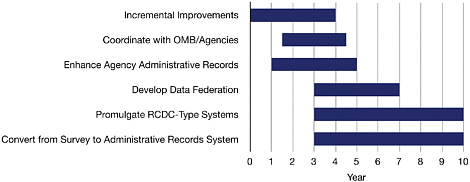6
The Path Ahead
The times are right for the federal research and development (R&D) statistics programs at the National Science Foundation (NSF). There is growing interest in building metrics to help science policy decision makers understand the role of government R&D spending in scientific advances and economic growth, and there are likewise strong forces propelling government agencies to enhance the content and accessibility of their administrative databases. Because of these forces, NSF has a prime opportunity to modernize its system of obtaining information on federal spending for research and development. And a third force is also at play. Pioneering work in the academic and computing worlds has led to protocols and solutions that promise to enable the federal government to structure, manage, and extract the massive amount of data residing in agency databases from which information on R&D spending is drawn. These conditions open new possibilities for the short- and long-term future, as this report discusses, and can, with effort, time, and resources, lead to a revolution in the way in which NSF obtains and presents the federal spending data.
Decisive action is required to capture these opportunities. One imperative is to obtain the cooperation of the Office of Management and Budget (OMB)—the agency that is driving the movement toward improving the databases. Laying a new foundation of trust and cooperation with the agencies that now report on their R&D spending to NSF is another imperative. The development of a strategic, long-term approach is yet another.
Simply trying to do things in the same way but better will not yield the necessary major long-term improvements in data quality when dealing with the myriad of relatively intractable agency management and report-
ing systems. NSF at present lacks the resources to significantly affect the way in which agencies manage and report their expenditures. Therefore, as NSF undertakes to work with agencies to make incremental improvements in reporting the survey information and continues to upgrade and to simplify its collection mechanisms as recommended in this report, the agency is advised to devote attention and resources to harnessing public policy interest in improving the reporting of federal spending, including R&D expenditures.
The E-Government Act and the Federal Funding Accountability and Transparency Act can be harnessed to provide powerful support in this effort, enabling NSF to advance in a manner that imposes little or no additional reporting burden on the reporting agencies. The strategic process that will lead to modernized collection should begin with some modest steps to shore up the current system while laying the basis for far-reaching changes later. To assist in visualizing this process, the panel suggests some broad, time-phased actions that, in essence, lay out the pathway to a modernized federal R&D spending data system (see Figure 6-1).
To move the collection of data on federal R&D spending from today’s survey-centric model to a modernized system could be accomplished in a series of overlapping steps. It is important, for the reliability and credibility of the current system, to make as many of the modest improvements suggested in Chapter 3 as early as possible. These changes will not only shore up the current system, but also will set the stage for coming major improvements.
At the same time as these modest improvements are under way, NSF should begin more systematic coordination with OMB, which has the responsibility for enhancing the quality and accessibility of agency contract and award data, and the Office of Science and Technology Policy, which has a key responsibility for assessing the contribution of federal R&D spending to economic growth and innovation. The immediate objective of this coordinated effort is to initiate a process that will lead to additional data items being incorporated into the administrative databases.
Taking lessons from the Research, Condition, and Disease Categorization (RCDC) system of the National Institutes of Health (NIH), NSF could take steps to promulgate agency-appropriate approaches to a more comprehensive system, one that includes taxonomic elements and permits cross-walks between program/projects and fields. It should be a priority for NSF to find ways to identify fields of science and engineering in data records at the program and project levels, perhaps through use of text-based technologies as described in Chapter 5. Finally, in graduated measure, NSF should develop the capacity for mining the standard and newly enriched government-wide contracts and awards databases to extract comprehensive information on R&D spending.

FIGURE 6-1 Pathway to a modernized federal R&D spending data system.
Bumps are expected along the path. For example, agencies may resist taking transparency down to the project level, where it could eventually be used to judge the worth of individual projects. Thus, an implementation strategy needs to incorporate a way to communicate and discuss the benefits of proposed solutions to the reporting agencies, to policy makers, and to the public.
The improvements recommended in this report will not be easy to implement. They would constitute a major coordination and information technology initiative. But the development of a cross-agency data federation and analysis framework building on administrative records and advanced retrieval technologies has great promise. As is becoming apparent in work going on in pioneering agencies, such as with the NIH RCDC project, and in the academic community where analysis has gained from advanced retrieval processes, there will be demonstrable gains in the efficiency, transparency, and analytical capacity for collecting and assessing federal investments in research and development.



